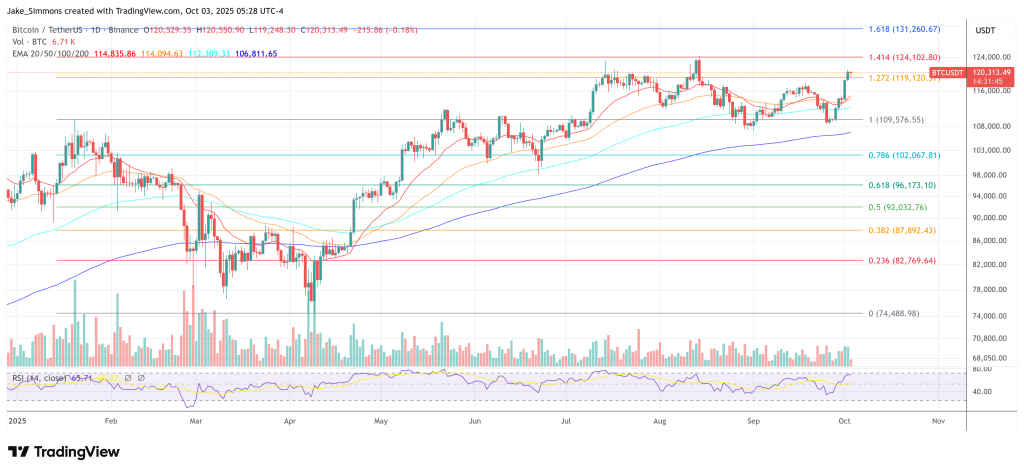In a comprehensive interview with Anthony Pompliano released on October 2, Jeff Park, partner and Chief Investing Officer at ProCap BTC, suggested that the rising price of gold and changing global ownership dynamics pose no threat to Bitcoin—instead, they could act as a catalyst for Bitcoin’s next major growth phase. Park’s argument focuses on liquidity flows, geopolitical shifts, and balance-sheet strategies: if large investors and policymakers learn to leverage the gains in sovereign gold holdings, they might divert a substantial amount of that liquidity into Bitcoin, potentially sparking what he termed a supercycle.
Why Gold’s Rally May Trigger A Bitcoin Supercycle
“The math is quite straightforward,” Park noted. “What if we could unlock the potential to leverage the paper gains from gold to acquire a call option on Bitcoin? There’s a significant opportunity here.” In his hypothetical analysis, “a trillion dollars invested in Bitcoin would massively impact the market.” He compared the scale of this potential infusion to the US fiscal issues, arguing that while it may seem minor next to public debt, it would carry great weight for a relatively young asset with a limited supply and low market float.
Related Reading
Park’s insights came in response to a fundamental query: why is gold soaring while Bitcoin has lagged behind? He acknowledged gold’s leadership—calling it “the story of the year”—but contended that the underlying drivers are different. Gold is currently the focal point of heightened geopolitical activity and central bank rebalancing, whereas Bitcoin’s adoption is dependent on institutional inflows that are still increasing. “Ultimately, these markets are influenced by flows,” he stated, asserting that Bitcoin’s inflows are “inevitable” as long as institutional strategies progress with “focused deliberation.”
A pivotal aspect of Park’s analysis is the evolving geography of gold ownership. He pointed out two concurrent trends: the significant notional increase in US gold reserves due to price fluctuations, and the lesser-known fact that the US share of global official gold has dramatically decreased over the decades. “After World War II, the US held over 50% of the world’s gold reserves as a central bank; now it’s dropped below 20%. Who is compensating for that? Likely China and other leading BRIC nations.” Park argued that this shift helps clarify why there remains strong demand for gold.
In his view, China is influencing the market not just through accumulation, but also by developing market infrastructures. He cited “the launch of the Shanghai Gold Exchange” and the emergence of “the Shanghai Futures Exchange,” noting that “physical gold is now actively traded in China” at volumes previously associated with London. A significant milestone this year was “the opening of vaults in Hong Kong to allow offshore investors to store their gold,” a move Park sees as part of a strategic initiative to bolster the creditworthiness of CNY-denominated commodity trade.
Will The US Act First?
Park connected this realignment of gold to Bitcoin’s potential demand. He described a scenario where the US could leverage substantial unrealized gains on its gold reserves if they were marked to market, possibly to acquire Bitcoin for its strategic holdings under President Donald Trump. “Gold is recorded at the Treasury at $42 an ounce, but it’s currently trading at around $3850… That’s a trillion dollars of essentially paper gains.” In this framework, he suggested that converting these paper gains into a scarce digital asset could serve as a high-risk upgrade to the sovereign balance sheet.
When questioned about the political feasibility of such a move, Park differentiated between executive action and legislative measures. “The executive route could serve as a significant starting point,” he indicated, but “no true democratic coalition will be united until legislation is enacted.” The former could signal intent; the latter would institutionalize a Bitcoin reserve strategy and align it with broader societal mandates he associates with sound money principles.
The essential element of his “supercycle” concept is compounding returns. Park illustrated return scenarios to show why a substantial base allocation—even if financed—could have profound implications over time. “If you own Bitcoin and anticipate a 12% annual increase, you’ll see a 30x return in 30 years… If you predict a 40% annual growth, which aligns with historical trends, it’s just 10 years.” He emphasized that the objective was not to promise these figures, but to demonstrate how modest returns can address substantial fiscal gaps when the base is sufficiently large and the asset holds credible scarcity.
Why Is Bitcoin Lagging Gold?
Park also tackled the question of why Bitcoin has not kept pace with gold recently. Part of the explanation, he presented, is perception: Bitcoin is “living, breathing software” that evolves through open discussion, whereas gold’s appeal lies in its immutability over centuries. The transparency of Bitcoin’s governance can intimidate newcomers who only perceive the chaos. “If I were an outside investor, say from BlackRock ETF, and I followed the discussions among Bitcoin developers, I might think, ‘This is somewhat chaotic.’” Nonetheless, he characterized current developer debates—like those on relay policy or spam filters—as minor issues rather than existential threats. They affect operational efficiency but not the fundamental monetary guarantees: “21 million or bust.”
Related Reading
He referenced the lessons learned from the block-size debate to illustrate that the system’s checks and balances are deliberate features, not flaws. “Ultimately, who conducts consensus in Bitcoin?… The node clients hold significant value and maintain control over miners and their interests. That was a critical moment as it demonstrated that decentralization is alive.” He acknowledged that the line between hard-coded rules and socially agreed norms will always prompt debate, but believes this process “future-proof[s] Bitcoin as the ultimate store of value.”
Throughout, Park emphasized the importance of flows. In his view, gold’s market movements are fueled by geopolitical factors and central bank behaviors—especially in Asia. Conversely, Bitcoin’s movements will be driven by institutional uptake and possibly by policy innovations that transform dormant balance-sheet strength into active demand. Hence, he perceives these assets as complementary in addressing the same macro challenges rather than competitors vying for a limited inflow.
“Gold’s cultural significance lies in its enduring presence and timelessness,” he explained. In contrast, Bitcoin offers aspects of sovereignty, portability, and programmability that resonate with younger generations. “Younger individuals are mentally more equipped to embrace concepts that older generations may find challenging… the trend of younger people recognizing digital wealth accumulation… represents significant progress.”
I spoke with @dgt10011 on whether we should be worried about bitcoin lagging gold’s performance, durability of bitcoin vs gold, how to think about bitcoin as living software, and a new theme referencing the retardification of society.
Enjoy!
YouTube: https://t.co/kwCRnibemU… pic.twitter.com/0BckI7h7Eb
— Anthony Pompliano 🌪 (@APompliano) October 3, 2025
If this generational transformation coincides with a government-level shift in balance sheets, Park believes the market structure could evolve rapidly. “A trillion dollars of Bitcoin would be significantly influential,” he reiterated, not because it resolves all issues immediately, but because it reorganizes incentives for issuers, custodians, and policymakers regarding a credibly scarce digital asset. In such a scenario, the current phase—where gold prevails and Bitcoin consolidates—might not be viewed as divergence, but rather as preparation.
“Bitcoin will catch up,” Park asserted. “Ultimately, these dynamics are driven by flows.” If those flows are initiated by the very gold rally dominating the headlines, the supercycle designation he embraces may not be an exaggeration, but a straightforward illustration of how compounding operates when fresh liquidity meets fixed supply limitations.
At press time, BTC was priced at $120,313.

Featured image created with DALL.E, chart from TradingView.com

